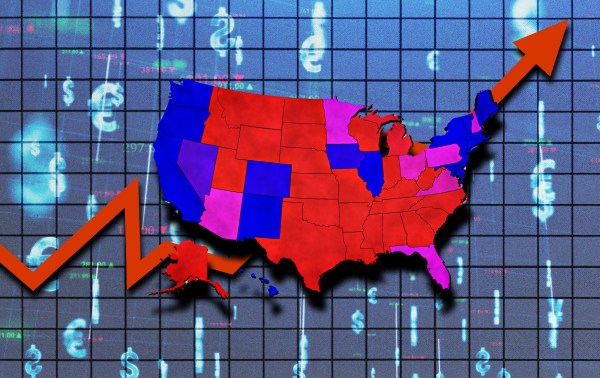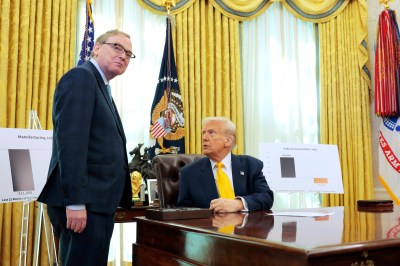Donald Trump has always had a mixed relationship with numbers. They are at once hard, objective truths that provide explicit measures of success: “huge ratings,” “polling like you wouldn’t believe.” But numbers also measure failure: skyrocketing COVID cases, losing election returns, and a slowing economy.
The president has long tried to bend the cold calculus of statistics to his personal will, refusing to recognize data that portrays his record as anything other than an unalloyed success. Trump’s selective faith in numbers came to a head last week when he fired the Bureau of Labor Statistics (BLS) Commissioner Erika McEntarfer following a dismal employment report that included large downward revisions for preceding months.
The employment report released on August 1 showed an estimated 73,000 new jobs added in July but revised June and May’s numbers down by a total of 258,000 jobs, suggesting the economy might be slowing down.
But the president refused to accept the updated numbers. “In my opinion, today’s Jobs Numbers were RIGGED in order to make the Republicans, and ME, look bad,” Trump posted on Truth Social. “Just like when they had three great days around the 2024 Presidential Election, and then, those numbers were ‘taken away’ on November 15, 2024, right after the Election, when the Jobs Numbers were massively revised DOWNWARD, making a correction of over 818,000 Jobs — A TOTAL SCAM.”
The president’s comments attempt to recast the history of jobs revisions in 2024 to falsely impute a partisan sheen to the data. The 818,000 fewer jobs he referenced were part of the BLS’ preliminary annual benchmarking that showed a weaker employment situation for the 12 months before March 2024. The agency released the revisions not in November but in August, well before the election. In fact, Trump at the time used the numbers as a cudgel against then-President Joe Biden’s economic record—he also falsely claimed that officials planned to not release the revisions until after the election but someone “leaked” them.
The jobs report released the Friday before Election Day also showed the opposite of the partisan pattern Trump asserts. The November 1, 2024, report showed only 12,000 new jobs in October, far below expectations. The subsequent two reports, released after Trump had won, revised October’s numbers upwards to 43,000.
Taking his allegations literally would mean that BLS data has been undermined by a partisan commissioner for years, something surely the president would have wanted to rectify on day one. But instead, Trump repeatedly touted the monthly jobs numbers since taking office—until they returned a result he didn’t like.
In fact, the president praised parts of the Friday employment report he claimed was rigged. In an interview with CNBC Tuesday morning, Trump reacted to the drop-off in jobs held by foreign-born workers, saying, “That’s a great number because it means we’re putting Americans back to work.”
Economists of all stripes and former BLS officials have decried the firing and claims of faked numbers. “It’s just simply not true,” Michael Horrigan, head of the W. E. Upjohn Institute for Employment Research and a former associate commissioner at the BLS, told The Dispatch. “That accusation is 100 percent unjustified, and I say that with confidence, having had 33 years at BLS, and from 2014 to 2019, I was in charge of the employment/unemployment numbers.”
William Beach, whom Trump nominated to lead the BLS during his first term, emphasized that the collection and analysis of jobs data is decentralized by design to guard against any political interference. The commissioner, a political appointee, has no role in producing the employment survey and only sees the final results two days before the public release. Beach told The Dispatch that a conspiracy to manipulate the data would be effectively impossible given the hundreds of people who work on the report.
“That’s part of the beauty of it—it’s like any kind of decentralized system, it’s very hard to attack,” he said. “It’d be another thing if there were five people out there collecting everything and processing everything. Then, you could have a great conspiracy. But I can’t imagine how it could be done [under the current system].”
Former officials also emphasized that the size of a given month’s revisions is not necessarily evidence of inaccuracy, let alone manipulation. The reason jobs numbers are revised every month is that the surveys of businesses that make up the jobs reports are conducted on a three-month timeline. BLS releases the first estimate of jobs data based on the responses the agency received before the report’s deadline, but the bureau continues to receive survey responses for a given month and issues revisions as part of the next two monthly reports.
Beach said that observers often misunderstand the revisions as evidence of errors. “They think, ‘Oh, well, it’s because they made a mistake the first time they’re trying to correct it.’ No, it’s because we’re getting more information,” he said. Economists have also pointed out that BLS’ first-month job estimates have become more accurate over the decades.
Instead of issuing monthly jobs reports, BLS could opt for quarterly or even annual updates where more information could be incorporated from less-frequently updated sources like state unemployment insurance records; BLS currently accounts for these sources in its annual benchmarking adjustments. But it’s important to economic decision-makers like the Federal Reserve and investors to have less-complete data sooner rather than more-complete data later, and prioritizing timeliness is why BLS is mandated to provide monthly updates.
The May and June jobs report revisions were some of the largest in decades, outside of those made around the pandemic. “The fact that they’re large is not something that occurs every month, but it happens, and it often happens when the economy is shifting,” Horrigan said, pointing to the large downward revisions in the beginning months of the 2008 recession—the first month estimate for September 2008 showed a decrease of 159,000 jobs which was updated to minus 284,000 in the first revision and minus 403,000 in the second revision.
The president’s tariffs have created economic uncertainty for many businesses, a factor that by itself wouldn’t increase the size of the statistical revisions. But if the companies responding later to the employment survey happen to be ones experiencing more disruption and uncertainty affecting their hiring decisions, then that information would show up in the revised rather than the initial job estimate.
The data collection and the models BLS uses to process the employment surveys and account for factors like seasonal employment trends are always in need of improvements, and a number of challenges have emerged since the pandemic. It’s always hard to measure a job market and economy that’s ever-evolving and introducing new goods and services, like artificial intelligence, that are tough to evaluate. The BLS also is contending with factors like declining survey response rates that make it more difficult and more costly to collect the same amount of data as before. But addressing those challenges takes time, resources, and additional personnel, things that the BLS and other statistical agencies have lacked for years.
Indeed, the former officials and economists The Dispatch spoke with were all concerned about the long-term integrity of economic data, not because of the threat of political manipulation raised by Commissioner McEntarfer’s ouster but the danger of a slow atrophying from lack of investment in statistical agencies.
Since 2009, BLS’ appropriations have not kept pace with inflation, and the Trump administration’s 2026 fiscal year budget proposal would cut 8 percent, or $56 million, from the BLS budget. “If you barely have the resources to put out the numbers that you’re mandated to do on a monthly basis, you don’t have the resources to plan and implement modernization projects,” Susan Houseman, a labor economist who chaired the BLS’ Technical Advisory Committee (TAC) for more than a decade, told The Dispatch.
Earlier this year, the Trump administration shuttered the advisory committees, including TAC, that worked with the BLS and other agencies to improve their statistical products and navigate resource constraints. The BLS has also struggled to fill vacancies as a result of the administration’s hiring freeze.
Ultimately, Trump’s false claims about jobs numbers are far from surprising. During the 2016 campaign, he called employment numbers phony only to laud them once in office. When asked about the change of tune, White House press secretary Sean Spicer quoted the president as saying, “They may have been phony in the past, but it’s very real now.” Spicer and the press pool laughed at the comment. Everyone expected Trump to be Trump.
What’s perhaps most concerning about the latest effort to sow doubt about the numbers is not only that no one in the White House dissuaded the president from firing the commissioner, but the claims of administration officials backing Trump’s attack on BLS.
When asked about evidence supporting claims that the numbers were rigged, National Economic Council Director Kevin Hassett said Sunday the large revisions themselves were the “hard evidence”—but in February, Hassett had no problem citing the downward revisions in the annual benchmarking, not as evidence of rigged data, but of a weakening economy during the tail end of the Biden administration.
In an interview Monday with CNBC, Hassett gave credence to the prospect of political interference in the numbers. “They could be politically manipulated because they’re so untransparent,” he said. “There’s a black box system out there making the jobs numbers that needs to be improved.” The BLS publishes on its site exactly how it calculates the employment estimates, along with a detailed breakdown of the monthly survey data.
Hassett also said he has long warned the BLS to modernize its data collection, referencing a 2015 BLS conference commemorating the 100th anniversary of the employment survey that he spoke at alongside former Federal Reserve Chair Alan Greenspan. “We warned that if they didn’t try to let the data collection and calculation keep up with the data that was happening in the economy then we would have problems like this,” he said Sunday, effectively blaming BLS for not heeding his advice 10 years ago.
Hassett’s 2015 remarks actually praised the work of the BLS and noted that the agency has the expertise to tackle data challenges but not sufficient funding or personnel. He emphasized that BLS staff should be doubled and warned people on the right against “starving” the data agencies of funding. “If we didn’t have good, truth worthy data, that we could all look at, whether we’re on the left or the right, to question how’s our society working, how’s it doing right now, then I think over time … it might have succumbed to being a propaganda device wielded perhaps at first by people on one side of the issue and then later on another,” he said at the time.
Greenspan’s 2015 comments offer something of a depressing retrospective. The former Fed chair told the conference that the extraordinary characteristic of U.S. data agencies like BLS is that nobody questions the integrity of the people who produce the estimates. “You can, in the payroll series, go back and revise your numbers significantly, and it can have very important political implications,” he said. “I don’t recall an instance in a very long time whether revised data, or any data, coming out of these agencies is politically tainted. That is not true in the rest of the world.”
Trust placed in the numbers, he added, “tells you a good deal about this country.”







Please note that we at The Dispatch hold ourselves, our work, and our commenters to a higher standard than other places on the internet. We welcome comments that foster genuine debate or discussion—including comments critical of us or our work—but responses that include ad hominem attacks on fellow Dispatch members or are intended to stoke fear and anger may be moderated.
With your membership, you only have the ability to comment on The Morning Dispatch articles. Consider upgrading to join the conversation everywhere.